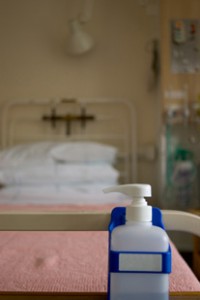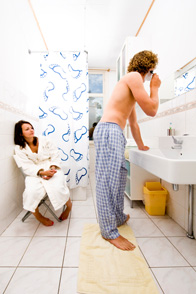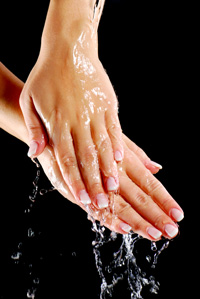By Steven Hutchings
 Methicillin-Resistant Staphylococcus Aureus, or MRSA, is a bacterium that causes infections in various parts of the body. People call it a ‘super bug’ because it’s potentially fatal and is notoriously difficult to treat.
Methicillin-Resistant Staphylococcus Aureus, or MRSA, is a bacterium that causes infections in various parts of the body. People call it a ‘super bug’ because it’s potentially fatal and is notoriously difficult to treat.
MRSA is a staph infection, with symptoms that typically appear as small red bumps. They look like pimples or boils, and they’re usually benign. However, in some people, they can turn into deep, painful abscesses that require surgical draining. The bacteria can go deeper too, into the bones, bloodstream, heart valves and feet.
Don’t get too paranoid about MRSA or related staph infections. The Center For Disease Control estimates that one-third of folks have a staph infection in the nose (nice, huh?). Roughly 2% of the population has the MRSA bacterium, with few infections to show for it. You’ll want to take practice basic hygiene, though, like regular washing and cover wounds to guard against potential complications, and see a doctor if a wound gets infected.
Staph infections, including MRSA, typically enter the body through a cut or wound, from where they can lead to trouble.
Researchers also suggest it’s important to clean surfaces with bleach – a finding further strengthened by a study released last month which found that MRSA thrives in many homes.
Why MRSA Has Been in the News
The media has labelled MRSA a superbug because it has become resistant to most antibiotics and is becoming more common in the community. That might be in part because of the rise in antibiotic use over the past 20 years. Observers say that half of antibiotic prescriptions are not required.
MRSA has, and continues to stay ahead of most antibiotics and those being developed. And that might be why MRSA, which for the most part was confined to hospitals and nursing homes in previous years, is showing up in younger patients.
According to the CDC, the average MRSA patient in a hospital setting is 68. In the community, it’s just 23.
Athletes are at higher risk of MRSA, especially with contact sports, because the bacteria can spread with skin-to-skin contact.
Two studies release in the past month stirred the MRSA pot further. The first, published in Proceedings of the National Academy of Sciences, revealed that MRSA often lives in homes and may spread when family members touch a common surface, like a counter or hygiene product.
And the second study, released last week, found that MRSA and E.coli can both survive on commonly touched surfaces in planes for up to a week. MRSA likes to sit on the reading material tucked in the seat pocket in front of you. E.coli prefers to live on the seat’s armrest, though they both linger in many places throughout a plane’s cabin.
How Do You Get MRSA?
You get MRSA by being in close proximity with other people, like in a hospital or on a sports team and/or touching a common object. MRSA spreads through contact. Risk goes up in situations including:
Hospitals – The traditional breeding ground for MRSA, the bacteria often targets the eldery and people with weakend immune systems. MRSA can infect surgical wounds too – another reason it likes this setting.
Invasive Medical Devices – Catheters and IV lines can be a convenient avenue for MRSA to the body.
Nursing Homes – MRSA often targets the eldery. Patients don’t have to be sick to carry the bacteria either.
In the community, risk factors for getting MRSA include:
Contact Sports – Athletes are at higher risk of MRSA, especially with contact sports, because the bacteria can spread with skin-to-skin contact.
Crowded and Unsanitary Living Conditions – Jails, military training camps and even child care centers can all spread MRSA.
Note too that MRSA is more common among homosexual men. And as you’re about to see, it can also spread by touching objects in the home.
MRSA Might Be In Your Home
A study released in April 2014 found that many homes are a reservoir for MRSA. The strain that keeps popping up is USA300 – the chief community strain – and it appears to spread through household items like counters, towels and razors.
In addition to skin, lung and bloodstream infections, MRSA can lead to pneumonia.
 The findings are based on 161 people in New York City, who contracted MRSA infections between 2009 and 2011, in which researchers compared swabs of the strain from these cases to people in a comparison group. The latter comprised of people in the same age who were not sick, to see if they harbored the MRSA bacteria.
The findings are based on 161 people in New York City, who contracted MRSA infections between 2009 and 2011, in which researchers compared swabs of the strain from these cases to people in a comparison group. The latter comprised of people in the same age who were not sick, to see if they harbored the MRSA bacteria.
They also tested members of each patient’s living quarters, some of their social contacts, and surfaces from each subject’s home to test for the bug. Their findings? Bacteria from each house was genetically similar compared to other homes – a sign the strain was alive and thriving in homes within the New York City area.
MRSA has also appeared in Tampa, through infections contracted by members of the Tampa Bay Buccaneers.
The findings come as no surprise, say researchers, because we typically see our family members more than anyone, including friends and coworkers. And they, like others, believe the bug moved to the community after it adapted to overuse of antibiotics.
One drug in particular – fluoroquinolones, like Cipro – may be responsible. The researchers note that mutations of USA300 began around 1995 in New York City and prescriptions for the drug skyrocketed by 50% between 1998 and 2008.
The takeaway message: be judicious with antibiotics. Use them only when your doctor feels they’re necessary, and then use them for the length your doctor prescribed, because bugs can survive and adapt to them.
Can You Prevent MRSA?
“It’s good to clean”, say the researchers from the New York study, who say that while the link between cleaning and MRSA is not proven, it can’t hurt to bleach countertops. Wash clothes and bedding with hot water if an infected person has used them too.
They also suggest patients should not use antibiotics to treat the common cold because they just kill bacteria. They’re useless against viral infections and people who do so contribute to overuse of antibiotics, which encourages MRSA to adapt and proliferate.
In addition, the Mayo Clinic suggests:
Your best defense against germs is to wash your hands often. Scrub briskly, for at least 15 seconds, and dry with a disposable towel. Use another towel to turn off the faucet, and have a small bottle of hand sanitizer with you, with at least 62% alcohol.
Wash Your Hands – Your best defense against germs is to wash your hands often. Scrub briskly, for at least 15 seconds, and dry with a disposable towel. Use another towel to turn off the faucet, and have a small bottle of hand sanitizer with you, with at least 62% alcohol, for when you don’t have access to soap or water.
Cover Wounds – We’ve already touched on this, but it’s worth repeating because MRSA often spreads through and infects wounds that are not covered. Keep wounds clean and covered, with sterile, dry bandages until they heal. Note the bacteria may spread through pus – another reason to stay clean and covered.
Keep Personal Items to Yourself – Try not to share razors, towels, sheets, clothing and athletic equipment. That’s often difficult in cramped quarters or if you’re on a team, but try, because MRSA often spreads through shared objects.
 Shower After You Play Sports – Do this immediately after you play or practice. Use soap and water, and dry yourself with your own towel.
Shower After You Play Sports – Do this immediately after you play or practice. Use soap and water, and dry yourself with your own towel.
Sanitize Linens – Wash clothes and bedding with the hottest temperature your machine will permit if you have a cut or sore. Add bleach if possible, and machine dry at high heat. Repeat this process for sports and athletic clothes each time you use them.
+Steven Hutchings




